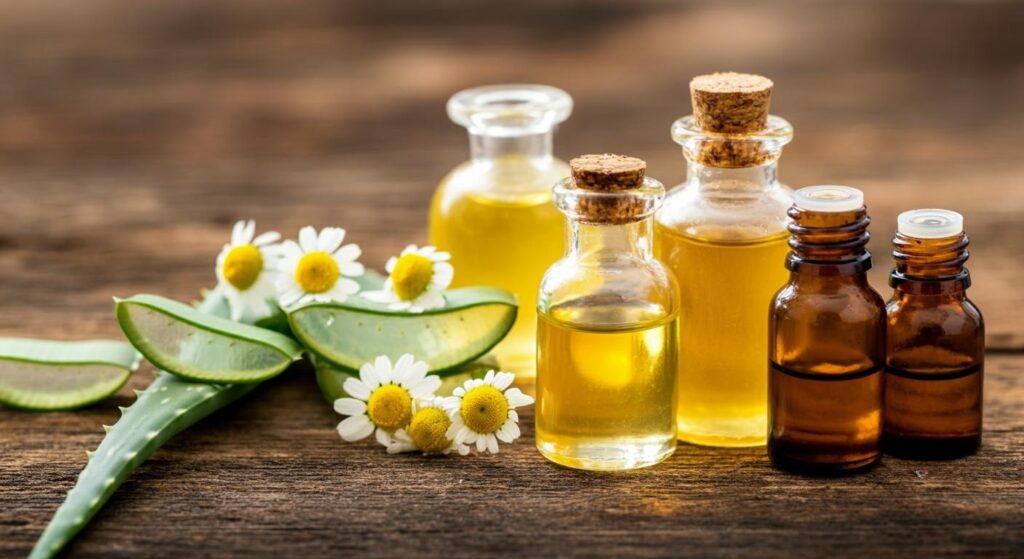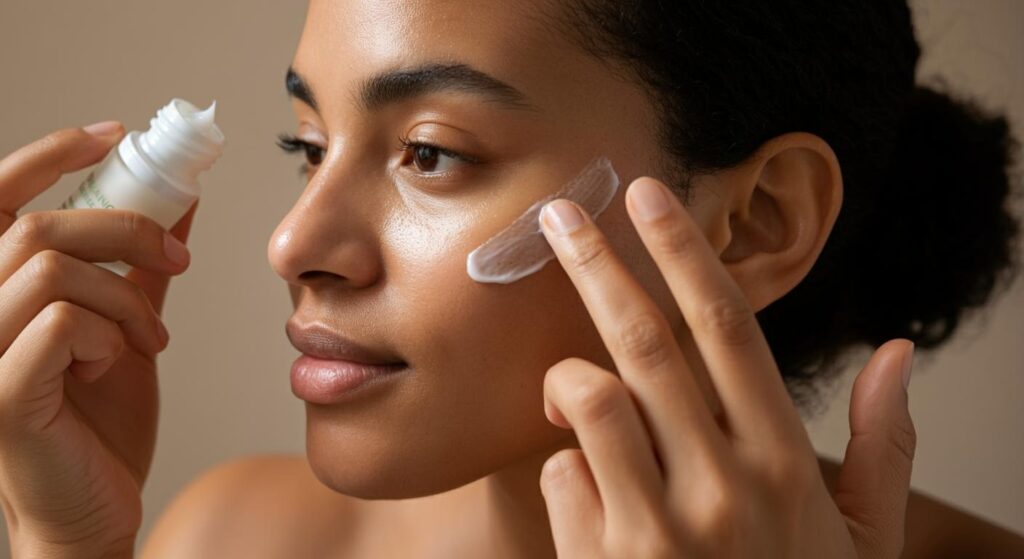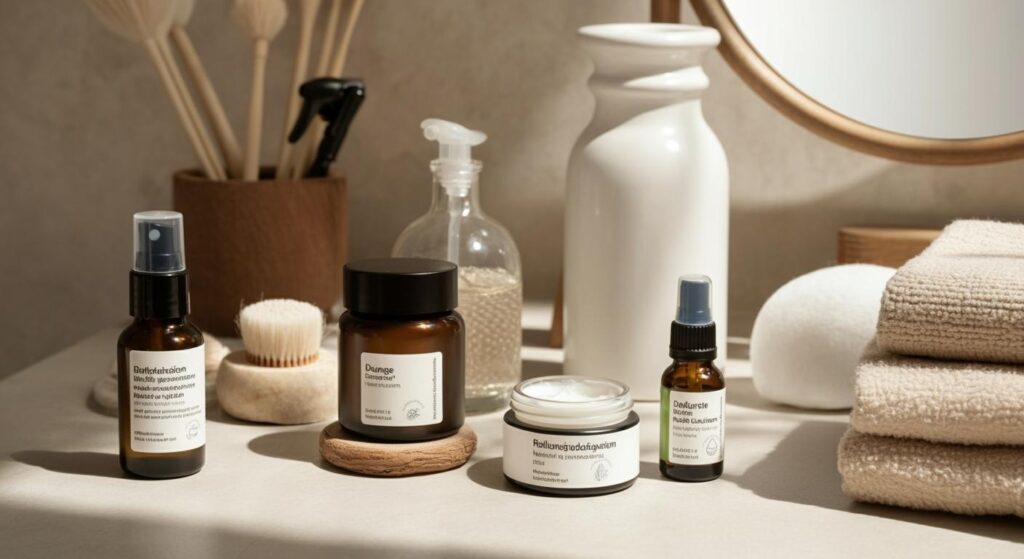Table of Contents
In a world where skincare products are endless, natural skincare has gained a special place in many routines. But what exactly makes it so appealing? The answer lies in the gentle, nourishing ingredients derived straight from nature. Natural skincare focuses on using plant-based extracts, oils, and botanicals to care for the skin without harsh chemicals, making it kinder to both our skin and the environment. Whether you’re dealing with acne, dryness, or dullness, natural products can work wonders for all skin types.
One of the biggest benefits of natural skincare is how it supports the skin’s natural barrier. Ingredients like aloe vera, jojoba oil, and rosehip oil are known to soothe, hydrate, and protect without causing irritation. However, as with any skincare routine, consistency is key. A regular routine helps your skin adjust, thrive, and maintain its glow.
The best part? This type of routine is totally adaptable! Whether your skin is oily, sensitive, or somewhere in between, natural ingredients can be customized to meet your skin’s unique needs. So, let’s dive into building a routine that works for you, no matter your skin type.
Understanding Your Skin Type
To achieve optimal results from any “natural skincare routine,” understanding your skin type is essential. Skin can generally be categorized into five primary types, each with unique needs and characteristics:
- Normal Skin: Balanced, neither too oily nor too dry. It’s characterized by minimal imperfections, fine pores, and a radiant complexion.
- Oily Skin: Produces excess sebum, leading to shiny skin and enlarged pores. It’s often more prone to acne and breakouts, benefiting greatly from a “natural skincare routine for oily skin” that incorporates lightweight, oil-balancing ingredients.
- Dry Skin: Lacks sufficient moisture, resulting in flakiness, rough patches, and sometimes irritation. Deep hydration from natural emollients like shea butter and avocado oil is critical.
- Combination Skin: Features both oily and dry areas, typically with an oily T-zone (forehead, nose, and chin) and drier cheeks. Tailored products that balance these needs without causing over-drying or excess oil production are ideal.
- Sensitive Skin: Easily irritated by environmental factors or certain products, making it crucial to use gentle, non-reactive ingredients. “Natural skincare for sensitive skin” often includes calming botanicals like aloe vera and chamomile.

How to Determine Your Skin Type
To identify your skin type, start by cleansing your face with a gentle cleanser. After an hour, observe how your skin feels:
- Oily skin will appear shiny, especially in the T-zone.
- Dry skin may feel tight or appear flaky.
- Combination skin will show both oily and dry areas.
- Sensitive skin may react with redness or irritation.
Tailoring Your Routine
Understanding your skin type allows you to customize your skincare regimen effectively. This ensures maximum benefits, such as using “Natural Skincare for Sensitive Skin” to avoid irritation or a “Natural Skincare Routine for Oily Skin” to control shine.
Step 1: Cleansing
Cleansing is the first and most crucial step in any “simple natural skincare routine.” It helps remove dirt, oil, and environmental pollutants that accumulate on the skin throughout the day, preparing your skin to absorb subsequent products more effectively.
A clean base ensures your skin can breathe and function optimally, reducing the risk of clogged pores and breakouts.

Natural Cleansing Options for Different Skin Types
- Oily Skin: Opt for lightweight, non-comedogenic cleansers such as tea tree oil or witch hazel to regulate sebum production without stripping the skin.
- Dry Skin: Gentle, hydrating cleansers like aloe vera gel or honey help retain moisture and prevent over-drying.
- Sensitive Skin: For those with easily irritated skin, soothing options like chamomile-infused water or rose water work wonders in maintaining a calm, balanced complexion.
How to Cleanse Properly
To maximize the benefits of natural cleansing, apply your chosen product to damp skin in circular motions, focusing on areas prone to oil buildup.
Rinse with lukewarm water and pat your skin dry with a soft towel. Incorporating this step daily will help maintain skin clarity and vitality, making it a foundational part of your routine.
Step 2: Exfoliation
Exfoliation is a vital step in any “natural skincare routine for beginners,” helping to remove dead skin cells, unclog pores, and reveal a smoother, more radiant complexion.
Regular exfoliation promotes cell turnover, which enhances skin texture, evens out skin tone, and allows other products in your routine to penetrate deeper and work more effectively.
Natural Exfoliation Methods
- For Dry or Sensitive Skin: Opt for gentle exfoliants like finely ground oats or rice powder. These soothing ingredients slough away dead skin cells without causing irritation.
- For Oily or Combination Skin: Exfoliants like sugar or ground coffee offer a bit more grit to remove excess oil and deep-seated impurities, making them ideal for a “DIY natural skincare routine.”
- For Normal Skin: You can use natural exfoliants like jojoba beads or mild fruit enzymes (papaya, pineapple) to maintain a balanced glow.
How Often to Exfoliate
- Dry or Sensitive Skin: Exfoliate once a week to avoid over-stripping the skin.
- Oily or Combination Skin: 2–3 times a week is ideal to prevent buildup and congestion. Regular exfoliation based on your skin type ensures a refreshed, glowing complexion without damaging your skin barrier.
Step 3: Toning
Toning is a key step in a “step-by-step natural skincare routine” that helps restore the skin’s PH balance after cleansing and exfoliating. It tightens pores, removes any lingering impurities, and preps the skin to absorb moisturizers and serums more effectively.
Incorporating a natural toner ensures that your skin is refreshed and balanced without the use of alcohol or harsh chemicals.
Natural Toning Ingredients
- For Oily or Combination Skin: Witch hazel and apple cider vinegar work as natural astringents, helping to control oil and minimize pores.
- For Dry or Sensitive Skin: Rose water, aloe vera, or cucumber extract provide gentle hydration while calming irritated skin.
- For Normal Skin: Green tea or chamomile-infused water offers antioxidant benefits and promotes an even complexion.
How to Apply Toner Effectively
To get the most out of your toner, apply it with a cotton pad or your fingertips, gently pressing it into the skin rather than rubbing. This ensures deeper absorption and a refreshing finish, setting the stage for the rest of your natural skincare routine.
Step 4: Serum Application
Serums play a pivotal role in the “best natural skincare routine,” delivering concentrated ingredients to address specific skin concerns.
Formulated with smaller molecules, serums penetrate deeper into the skin, targeting issues such as fine lines, hyperpigmentation, and dehydration. By including a serum in your routine, you can treat multiple concerns simultaneously for optimal results.
Natural Serum Options for Different Skin Concerns
- For Anti-Aging: Look for serums rich in antioxidants like vitamin C or resveratrol, which help to combat free radicals and reduce the appearance of fine lines and wrinkles, making them essential in a “natural skincare routine for anti-aging.”
- For Hydration: Hyaluronic acid derived from plants or sea kelp extracts can deeply moisturize, plumping the skin and improving elasticity.
- For Brightening: Niacinamide (vitamin B3) or licorice root extract helps fade dark spots and even skin tone naturally.
Proper Application Techniques
Apply a few drops of serum onto clean, toned skin. Gently press the product into the skin with your fingertips, ensuring full absorption without dragging or pulling. Incorporating this step daily amplifies the benefits of your natural skincare routine, leaving your skin radiant and revitalized.
Step 5: Eye Care
The skin around the eyes is thinner and more delicate, making targeted eye care essential in any “nighttime natural skincare routine.” Eye creams or serums address common concerns like puffiness, dark circles, and fine lines, helping to maintain a youthful, refreshed look.
Natural Ingredients for the Eye Area
- For Puffiness: Cucumber extract and caffeine reduce swelling and refresh tired eyes.
- For Dark Circles: Green tea and vitamin K brighten the under-eye area.
- For Fine Lines: Aloe vera and rosehip oil provide hydration and improve skin elasticity.
Gentle Application Methods
Use your ring finger to apply a small amount of product, gently tapping around the eye area. Avoid pulling or rubbing to prevent further stress on this sensitive skin. Regular, gentle care ensures long-term vitality and smoothness.
Step 6: Spot Treatment
For those dealing with acne, dark spots, or blemishes, spot treatments are a vital addition to a “natural skincare routine for acne” and other targeted skin issues. This step addresses specific concerns without affecting the surrounding healthy skin.
Natural Spot Treatment Ingredients
- For Acne: Tea tree oil and witch hazel act as natural antiseptics, reducing inflammation and bacteria.
- For Dark Spots: Licorice extract and vitamin C help lighten hyperpigmentation and promote an even skin tone.
How to Incorporate Into Routine
After cleansing and applying serum, dab a small amount of your DIY spot treatment onto problem areas. Use it consistently within your routine to see gradual, visible improvement.
Step 7: Moisturizing
Moisturizing is a crucial final step in every “simple natural skincare routine,” regardless of skin type. It seals in hydration, strengthens the skin’s barrier, and helps maintain a balanced moisture level, preventing issues like dryness, excess oil production, or premature aging. Even oily skin benefits from moisturizing, as it can help regulate sebum levels.
Natural Moisturizing Ingredients
- For Oily Skin: Lightweight oils like jojoba or grapeseed help balance oil production without clogging pores.
- For Dry Skin: Rich emollients such as shea butter and avocado oil deeply hydrate and nourish.
- For Sensitive Skin: Aloe vera and chamomile-infused moisturizers soothe and protect, making them ideal choices for “natural skincare for sensitive skin.”
How to Choose the Right Moisturizer for Your Skin Type
- Oily or Combination Skin: Opt for gel-based or lightweight formulas that won’t feel greasy.
- Dry Skin: Choose thicker, oil-based moisturizers for long-lasting hydration.
- Sensitive Skin: Look for fragrance-free, hypoallergenic options with calming natural ingredients to avoid irritation.
Regular moisturizing ensures your skin stays soft, supple, and healthy.

Step 8: Face Oil Application
Face oils are a luxurious addition to the “Best Natural Skincare Routine,” offering intense hydration and nourishment. They help lock in moisture, enhance skin elasticity, and provide a radiant glow.
Natural Oil Options for Different Skin Types
- Normal Skin: Jojoba oil balances and hydrates.
- Oily Skin: Grapeseed oil regulates sebum production.
- Dry Skin: Argan oil deeply moisturizes and soothes.
- Sensitive Skin: Rosehip oil calms and reduces redness.
How to Apply Face Oils
For those following a “Natural Skincare Routine for Beginners,” apply oil after cleansing and moisturizing. Warm a few drops between your palms and gently press onto your face and neck, allowing it to absorb fully.
Step 9: Sunscreen Application
Incorporating sun protection is crucial for a “Morning and Night Natural Skincare Routine.” It prevents premature aging and reduces the risk of skin cancer.
Natural Sunscreen Options
Opt for mineral-based sunscreens with zinc oxide or titanium dioxide. They provide broad-spectrum protection and are gentle on the skin.
How to Incorporate Sunscreen
Apply sunscreen as the final step in your morning routine. Use a generous amount on your face, neck, and any exposed areas. Reapply every two hours when outdoors for optimal protection.
Step 10: Weekly Face Mask
Incorporating face masks into your “DIY Natural Skincare Routine” can deeply cleanse, hydrate, and rejuvenate the skin, enhancing overall complexion.
Natural Face Mask Ingredients for Different Skin Types
- Normal Skin: Honey and yogurt for gentle hydration.
- Oily Skin: Clay and tea tree oil to absorb excess oil.
- Dry Skin: Avocado and olive oil for intense moisture.
- Sensitive Skin: Oatmeal and chamomile to soothe irritation.
How to Incorporate Masks
For those following a “Natural Skincare Routine for Beginners,” apply a mask once a week after cleansing. Leave it on for 10-15 minutes, then rinse with warm water.
Adapting the Routine for Day and Night
A morning and night natural skincare routine addresses distinct needs: morning routines focus on protection and hydration, while evening routines emphasize repair and recovery.
Modifying the 10-Step Routine
- Morning:
- Cleanse to remove overnight impurities.
- Use an antioxidant serum to protect against environmental stressors.
- Apply a lightweight moisturizer and sunscreen for protection.
- Night:
- Double cleanse to remove makeup and pollutants.
- Apply a nourishing serum and richer moisturizer to aid skin regeneration.
- Consider adding a retinol or peptide treatment for enhanced repair.
Focus Products for Each Time of Day
- Morning:
- Vitamin C serum
- Sunscreen
- Night:
- Retinol or peptides
- Hydrating mask for deep nourishment
By tailoring your routine, you optimize your skin’s health and appearance, ensuring it receives the care it needs around the clock.
Tips for Maintaining Your Natural Skincare Routine
Consistency is key in any “Affordable Natural Skincare Routine.” Results take time, so patience is essential for seeing long-lasting improvements.
Listening to Your Skin
Stay attuned to your skin’s reactions. If a product causes irritation, adjust or remove it from your routine. Your skin’s needs can change due to factors like weather or stress.
Adjusting Your Routine
Be flexible. Modify your routine as necessary, incorporating seasonal changes or addressing specific concerns like dryness or breakouts.
Importance of a Healthy Lifestyle
A balanced diet, regular exercise, and adequate hydration support overall skin health. These “Natural Skincare Tips” enhance your routine’s effectiveness, promoting a radiant complexion from within.
Embrace Your Natural Skincare Journey
Embarking on a “Natural Skincare Routine” can transform your skin’s health and radiance. This 10-step regimen ranging from cleansing to sunscreen application offers a comprehensive approach to skincare.
By incorporating natural ingredients tailored to your skin type, you’ll discover the “Best Natural Skincare Routine” for your unique needs. Start your journey today and embrace the benefits of nature-driven care.
Remember, if you experience persistent skin issues, consulting with a dermatologist is essential to ensure your routine meets your skin’s specific requirements. Enjoy the path to a healthier, glowing complexion!
FAQs
Natural skincare routines can be both exciting and overwhelming for beginners. To help you navigate your journey towards healthier, more radiant skin, we’ve compiled answers to some of the most common questions about natural skincare routines.
What is the best natural skincare routine for sensitive skin?
A gentle routine with soothing ingredients like chamomile and aloe vera is ideal. Focus on fragrance-free products to minimize irritation.
How do I start a natural skincare routine?
Begin with basic steps: cleanse, moisturize, and protect with sunscreen. Gradually introduce natural products to see how your skin reacts.
What are some simple steps to create a natural skincare routine?
Cleanse with a gentle, natural cleanser.
Hydrate with a natural moisturizer.
Protect with mineral-based sunscreen.
Exfoliate weekly with a gentle scrub.
What products should be included in a natural skincare routine?
Include a cleanser, toner, moisturizer, sunscreen, and treatments like serums or masks with natural ingredients.
How often should I update my natural skincare routine?
Assess your routine every season or when your skin’s needs change. Adjust products to address new concerns.
What are some natural skincare tips for beginners?
Start simple, patch-test new products, and be consistent. Focus on hydration and sun protection as foundational steps.
How can I customize a natural skincare routine for oily skin?
Use lightweight, non-comedogenic products. Incorporate ingredients like witch hazel and clay masks to control excess oil.
What is the difference between a daytime and nighttime natural skincare routine?
Daytime focuses on protection (antioxidants and sunscreen), while nighttime emphasizes repair (hydrating and restorative treatments).
Are DIY natural skincare routines effective?
They can be, using fresh, high-quality ingredients. However, ensure formulations are safe and suited to your skin type.








